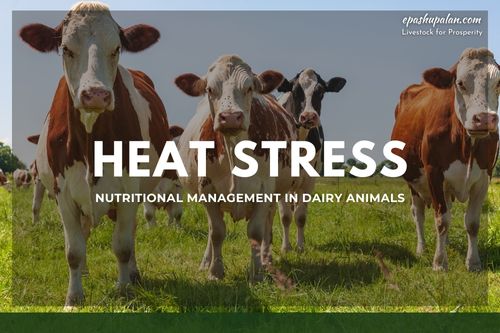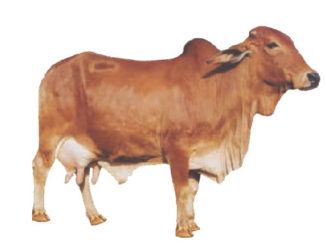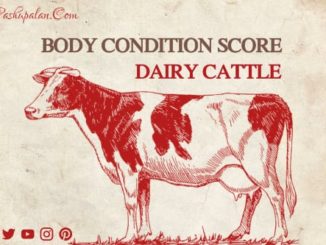Introduction
Heat stress is a serious problem throughout our world. Environmentally brought hyperthermia in dairy animals leads to significant production losses. As global warming continues, the occurrence of heat stress in animals increases in terms of duration, frequency, and severity. Modern dairy farming practices (mainly cattle and buffaloes) have raised internal heat loads because of their high milk production and as a result of increased temperature and humidity from the surroundings. To avoid this extra heat, these animals initiate different adaptive mechanisms including increased sweating, respiration rate, panting, reduced milk yield, vasodilatation, and reduced reproductive performance. And the consequence includes mortalities and serious economic loss.
The substantial changes in physiological processes and feed intake occur with temperatures higher than 25oC. This is applicable for dairy animals in temperate conditions. While coming to the tropical region, the temperature-humidity index is the best indicator for heat stress. But, the thermal comfort zone changes depend on several other factors such as the humidity of the surrounding and wind speed, genotype of the animal, its physiological state, thermal susceptibility, acclimation, and the diet offered. Animals try to maintain their body temperature by increasing heat loss and reducing heat production by behavioral and physiological responses. Strategies for the alleviation of heat stress include physical modification of the environment, genetic development of less sensitive breeds, and improved nutritional management schemes using dietary water, protein, fat, fiber, micronutrients, and feed additives.
Different nutritional approaches have been known to cope with high surrounding temperatures, like the use of a high energy diet to balance decreased feed intake and increased energy demand for thermoregulation and adding proteins with low rumen degradability to balance increased nitrogen catabolism. The genetic selection of heat-tolerant breeds is another method such as crossbreeding. An alternative approach is a ventilation coupled with the surface soaking of animals. Animals wetting by sprinklers, foggers, misters, etc. according to a situation that varies. Evaporative cooling may be useful in various parts of the dairy like the holding area for milking, rest area, the feeding lane, etc.
When an animal fails to lose radiant heat, mainly through convection, it suffers from heat stress. Conventionally, the temperature-humidity index is mainly used to assess heat stress in dairy production. Temperature humidity index (THI) is a simple method to assess and measure heat stress (HS). It works based on humidity and ambient temperature. High-producing dairy animals begin to experience HS at a THI of 65-68. As a comprehensive classification, the level of stress can be divided into light (68-71), moderate (72-79), severe (80- 89), very severe (>90), and deadly (>100). Signs of heat stress include reduced rumination, increased CO2 output, increased respiration and panting, decrease in growth, reduced feed intake, reduced milk production, decreased fertility, reduced carcass quality, increased sweating, and finally these all lead to higher mortality rate.
High milk yield and prolificacy of dairy animals require high metabolic activities to support. This causes high heat production in the body, which united with increasing surrounding temperature will result in heat stress. Animal activates a variety of endocrine, physiological and behavioral mechanisms to deal with heat stress. Usually, reduced feed intake is considered as the major factor towards negative energy balance leading to a decrease in milk production.
Physiological and behavioral modifications of the dairy animals during heat stress
Homoeothermic animals have a thermo-neutral zone where energy expenditure to maintain the body’s normal temperature is minimum, constant, and not dependent on the surrounding temperature. Initial responses to heat stress include increased sweating, water intake, respiration rates, reduced heart rate, and feed intake. If heat load is increased, heat acclimation is achieved by processes of acclamatory homeostasis. But this acclamation may not remain homeostatic if heat stress is continued and by that time the animal will initiate homeostatic mechanisms to dispel incremental heat load and acclimatize to stress conditions. Increased heat dissipation, mainly through evaporative heat loss, decreased feed intake and reduced milk yield and increased water intake are the characteristic signs of homeostatic responses in response to heat stress. When the hypothalamus sense temperature above the thermo-neutral zone, the heat loss mechanisms, such as sweating and vasodilatation gets activated. Heat-stressed animals consume less amount of feed and consequently ruminate less, and this results in decreased buffering agents entering the rumen. Also, the redistribution of blood flow to the periphery (in an attempt to enhance heat dissipation) and subsequent reduction in blood delivery to the gastrointestinal tract, thus disturbing the digestion process.

Nutrients and feeding Management
Nutritional management approaches for livestock during summer conditions are focused on using high-energy diets, micronutrients, feed additives, and antioxidants, managing the proportion of roughage in the diet, and altering feeding time to reduce metabolic heat loads during the hotter hours of the day, etc.
Water Intake
Ambient conditions, diet type, breed, weight, and various physiological and metabolic activities all influence the water requirements of animals. Many physiological activities, such as internal body temperature regulation, growth and development, lactation and reproductive functions, digestion and metabolism, protein, fat, and carbohydrate hydrolysis, ultimately influence daily water intake. DMI is linked to water intake, which is influenced by both feed intake and feed type. The quantity of water received by drinking, eating, and metabolic water, as well as the amount of water lost per unit time through respiration, sweating, faeces, urine, and breastfeeding, all influence water intake. Increased water consumption during the summer is owing to increased urine volume, respiratory tract evaporation, and evaporative heat loss, which is primarily due to sweating. However, an increase in water consumption could indicate ruminants trying to adjust for heat loads, especially in grazing areas that are not shaded. As a result, an appropriate water supply for the animals should be guaranteed during heat stress.
Dietary fiber
Heat-stressed animals have lower energy usage efficiency. This is due to the increased maintenance requirement associated with removing the extra heat load. Additional sources of heat output from dairy animals could come from digestion and metabolism. Diets high in fibre may increase heat output. Acetate metabolism (linked to a high fibre diet) generates more endogenous heat than propionate metabolism (related to a high concentrate diet). Ruminants fed low fibre diets (NDF 30 percent of DM) during hot weather had higher daily milk production, lower body temperature, and lower respiratory rates than those on high fibre diets (NDF 42 percent of DM), according to research. Following that, intake has a significant impact on heat generation, and its significance in developing an effective nutritional and environmental management programme must be carefully considered. In lactating dairy animals, reducing NDF from roughage reduced HS-related symptoms such as respiratory rate and rectal temperature, while improving DMI and milk production. Nutrient requirements change during HS in hot conditions, necessitating diet reformulation. In dairy animals, nutritional treatment may be able to recover a percentage of the milk production lost (35–50%) due to heat stress. If milk yield is to be maintained at a level comparable to that in thermo-neutral conditions, the fall in DMI and related efficiency of nutrition utilisation necessitates a high dietary nutrient density. Low metabolic heat increment diets for ruminants can help increase feed intake and performance under HS circumstances. Dietary fibre, on the other hand, is essential for normal rumen activity and supply. It is hypothesised that feeding slowly fermentable grains to dairy animals throughout the summer would lower the amount of heat emitted from fermentation and digestion, hence improving physiological responses to heat stress and increasing productivity.
High fermentable carbohydrate diets can be used under hot conditions to stimulate energy intake, but this positive effect must be balanced with the potential for rumen acidosis associated with high-grain diets. To avoid this disorder is important to maintain the optimal rumen function, with a level of ADF and NDF that should not be lower than 18% and 28% on the dry matter basis of the diet, respectively.
Dietary Protein
Many studies have shown that heat-stressed dairy animals have a negative nitrogen balance as a result of their reduced feed intake. The decrease in feed consumption can be offset by increasing the protein content of the diet, although this can result in an excess of nitrogen intake. During HS, feeding too much rumen degradable protein resulted in lower DMI and milk output.
The metabolic consumption of crude proteins increases endogenous heat output, which is larger than that of carbohydrates or fat. Urea production and higher protein turnover are both linked to a higher heat increment from crude proteins. Under heat-stress situations, the quality of the protein source should be addressed in addition to the amount of protein provided. Despite this, a diet high in rumen-undegradable proteins did not increase the performance of dairy animals under adverse climatic circumstances.
Essential amino acids in the diet may help to reduce the risk of HS. HS inhibits RNA transcription and translation, resulting in a decrease in milk protein production. For dairy animals, methionine is one of the most important limiting amino acids. Supplementing with methionine boosts milk production and antioxidant capability while also lowering lymphocyte apoptosis. During heat stress, lysine was also found to be beneficial.
In conclusion, if DMI is low during HS, it is vital to increase the amount of protein in the diet. However, given a diet with appropriate energy availability, it is crucial to feed rumen undegradable proteins or increase protein quality by increasing the level of essential amino acids (especially methionine and lysine). Despite these factors, more research into the effectiveness of dietary protein consumption is required.
Dietary Fat
In dairy animals, a large reduction in feed intake under heat stress causes a negative energy balance, in which energy intake is insufficient to meet lactation requirements. To alleviate the energy deficit and minimize thermogenesis, the typical treatment for this problem is to supplement the diet with more fat (because fat generates less heat increment than dietary carbohydrate or protein).
In comparison to fibre or starch, fat supplementation enhances net energy intake in heat-stressed dairy animals due to its higher energy density and lower metabolic heat. Dairy animals fed diets supplemented with protected tallow used metabolizable energy more efficiently for lactation under thermo-neutral conditions than those not getting additional tallow. In a recent study, a supplement containing 3% unprotected fat was recommended for usage during the hot summer months. Higher circulatory NEFA concentrations were found in heat-stressed Holstein dairy cows fed a higher calorie diet, indicating a reduction in the energy deficit. As a result, milk yield increased dramatically from 28.5 to 30.4 kg/day, but milk fat content decreased. Unprotected fat supplementation is thought to have disrupted ruminal fermentation, lowering the ruminal acetate to propionate ratio and thus milk fat synthesis.
Ruminally-protected fats in the diet considerably reduce metabolic heat increment, improving lipids’ role throughout the heat-stress phase. Under thermo-neutral conditions, the high-fat levels resulted in a noticeable decrease in heat output. Despite the lack of solid evidence about the benefits of fat supplementation, fats should be utilised with extreme caution in heat-stressed animal diets. Using treated fat, which bypasses the rumen environment intact and so does not affect rumen microbial growth, is clearly the best alternative. More research is needed to examine different amounts and sources of fat supplementation throughout time.
Dietary Micronutrients
Micronutrients are little amounts of vital substances that life requires. Major minerals, micro/trace minerals, and vitamins are all included. Micronutrients assist animals to maintain their production, enhance their nutrient utilisation, effectively neutralize oxidant stress, and strengthen their weakened immune systems. Minerals are necessary for animals to maintain regular physiological activities. Heat stress responses, on the other hand, are applied to influence mineral loss through excretion in animals. As a result, adding mineral supplements to the diet (DCAD, Zinc, Chromium, Selenium, and so on) may help to mitigate the negative effects of thermal stress. Vitamins operate as cofactors for enzymes, act as catalysts in a variety of metabolic pathways, and are necessary for animal growth and development. Supplementing the feed of dairy animals with vitamins (Vitamin E, Niacin, etc.) may also help to alleviate the detrimental effects of heat stress.
The increased amount of dietary chlorine in feed is much more detrimental to dry matter intake during summer. A study shows that ingestion of CaCl2 increases plasma chlorine concentration, which exceeds the bicarbonate buffering power capacity and produces metabolic acidosis, thereby appearing to suppress appetite in pigs. When animals, particularly dairy animals, are given diets with negative cation to anion balance (i.e. more anions than cations) or calcium chloride causes an acidifying effect, it is known as hyperchloremic metabolic acidosis.
Dietary cation-anion difference (DCAD) has been defined as milliequivalents of (Na + K) – (Cl + S) per kilogram of dry matter and has a direct impact on blood acid-base metabolism. Dietary cation-anion difference calculated using Na+, K+, and Cl− concentrations, has a significant effect on health status and productivity by influencing acid-base balance. Serum total amino acid and essential amino acid concentrations and the ratio of essential amino acid to total amino acid were greater for high DCAD. These results suggest that increasing DCAD improves amino acid availability for protein synthesis that would otherwise be taken for the maintenance of acid-base balance. A positive Dietary cation-anion difference diet of +350 mEq/kg dry matter improved the immunity status and nutrient intake by ameliorating heat stress. Keeping the dietary cation-anion difference at a healthy lactating level remains a good strategy for reducing thermal stress during the warm summer months.
Zinc is an important micromineral, involved in productive performances like growth, immune system, and reproduction, and involved in a wide range of metabolic activities. Zinc plays a critical role in antioxidant defense as an integral part of the superoxide dismutase (SOD), which is an essential enzyme. The deficiency of zinc has been reported to cause an increase in oxidative DNA damage and impair antioxidant functions. Zinc supplementation lessens the heat shock protein response and enhances immunity in heat-stressed peripheral blood mononuclear cells of periparturient dairy animals.
Chromium is another favorable micronutrient to defy the adverse effects of heat stress in animals. It acts as an excellent antioxidant that prevents heat-stress-induced lipid peroxidation. Chromium improves cortisol hormone activity and nutrient metabolism. It promotes insulin action in responsive tissues, thereby increasing farm animal productivity.
Selenium is an essential trace mineral that is an indispensable component of the antioxidant system. It decreases the adverse effects of heat stress on metabolism and redox balance, resulting in improved dairy animal health, immune function, and milk quality. Studies show that in heat-stressed animals, there is a significant reduction in plasma selenoprotein, diet supplementation with selenium can significantly raise plasma selenoprotein and selenium concentrations, which might be a potential mechanism to protect dairy animals from heat stress.
Vitamin E is an antioxidant that is essential for body functions like growth, immunity, tissue integrity, reproduction, and preventing oxidative stress. Elevated temperature and humidity in summer will lead to greater oxidative stress for animals, so feeding of additional vitamin E is required. Due to the potent antioxidant properties of tocopherols, the impact of α-tocopherol in the prevention of chronic diseases believed to be associated with oxidative stress has often been studied and beneficial effects have been observed.
Niacin has been reported to be a vitamin that resists the heat stress in dairy animals by increasing evaporative heat loss in vivo and cellular heat shock response by increasing gene expression of heat shock proteins during thermal stress in vitro. Niacin (vitamin B3) supplementation increases resistance to heat stress by inducing greater cutaneous vasodilatation and blood flow. A study conducted at NDRI showed that 800 ppm niacin supplementation to lactating crossbred cattle resulted in better heat stress alleviation.
Feed Additives
Fungal culture and plant extracts may have a beneficial effect on rumen metabolism and body temperature control. Saccharomyces cerevisiae was one of the most investigated fungus cultures. Live yeast supplementation may improve nutrient digestion and feed efficiency while also regulating ruminal pH. In heat-stressed dairy animals, yeast supplementation resulted in improvements in DMI, feed efficiency, and lactation performance. Under HS, nutrient flow to the small intestine and dairy animal performance may be improved by feeding measures that boost digestive efficiency, such as live yeast supplementation. The addition of a mixture of exogenous enzymes and yeast culture to heat-stressed dairy animals lowered rectal temperature, implying a role for thermoregulatory functions. In certain studies, Aspergillus oryzae was found to reduce the rectal temperature of heat-stressed animals.
Daidzein was found to be a good promoter of antioxidant power in heat-stressed late lactation cows, owing to an increase in glutathione peroxidase plasma activity. When fed at 0.25 g/kg DM, extract from Radix bupleuri showed antipyretic effects in heat-stressed nursing dairy animals, lowering the rectal temperature, lowering the respiratory rate, and enhancing feed efficiency.
Conclusion
Because of the deleterious effects on ruminant performance, heat stress is becoming a serious problem. As global warming increases and genetic selection for milk yield continues, the detrimental effects of HS will become more severe in the future. In response to weather changes, heat-stressed animals adjust their metabolism and physiology. The direct and indirect effects of HS on gastrointestinal health and functionality have a significant impact on diet consumption efficiency. When nutritionists approach the development of diets for heat stress, they should take into account changes in nutrient partitioning as well as changes in the rumen and intestinal functionality. Water availability and its temperature may represent a key tool to promote DMI and alleviate heat load subtracting heat from the body.
Continued advances in feeding are necessary as dairy animals are selected for high milk yield, but at the same time, are subject to a reduction of DMI because of environmental stress. Developing nutritional strategies which support milk yield but which also address metabolic and physiologic disturbances caused by HS will help the dairy animal to maintain a more normal metabolism which should promote performance.






Be the first to comment